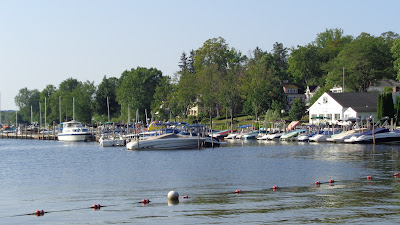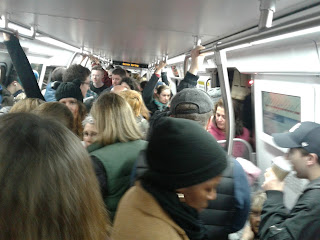We knew that Chautauqua Institution's 's origins were Methodist.
We also knew that Chautauqua Lake's far corner of upstate New York was way west
of the old Jewish Catskills; far, even, from the more adventurous Adirondaks,
where Ben and Jerry's has outposts in at least two towns. So far from our roots
was Chautauqua that we heard about it from Connecticut Yankees, now related
through marriage. They assured us that
there was a Jewish denominational house there, where maybe we could still book
a place to stay.
If we'd wanted. But we
didn't. We were more interested in rubbing shoulders with Christian fellow
humanists than in bunking with our own kind, although we certainly did check in
at the local branch. The Everett Jewish Life
Center, built in 2009, was beautiful, with the same lush hostas and hydrangeas
and welcoming, wrap-around porches and rocking chairs as all the other
denominational houses, only newer. More
horizontal Danish modern than Victorian gingerbread. And a schedule of films,
talks and classes for all and any Chautauquans. I'm pretty sure I saw Rabbi
Telushkin, a scheduled speaker, walk out of the place on his way somewhere.
We booked a tiny efficiency in one of the Victorians on the
streets between the town square and the lake. A bedroom not much bigger than
the bed, a living room/kitchen by virtue of a couch, an end table and a
wall-mounted TV, and half a little balcony with a partial view of the lake. A sign
on the door in our hall warned that an alarm would sound if opened; it clearly gave
out into the other apartment that had been carved out of the third floor. We saw and heard very little of our
neighbors, who of course, turned out to be Jewish. Fellow first-timers, the husband was a
lawyer from the DC area. The wife had
heard of Chautauqua through her Hadassah group.
And that's the way it went. We kept bumping into Jews,
sometimes on purpose and sometimes not. Maybe it's because that week's theme
was comedy, in collaboration with the National Comedy Center planned for the
nearby city of Jamestown, birthplace of Lucille Ball (not Jewish). Maybe because my husband has a clearly Jewish
punim and I'm identifiable with just a little more Jewdar, I think, and
a good ear.
We met a couple at a church basement supper; I was ready for
an intercultural encounter until the husband told me how his dad had grown up
on a south NJ chicken farm. Ah. A recognizably Jewish story; every Jew in
Jersey knows someone whose grandparents raised chickens in Vineland. These folks eating nice goyisch turkey with us
lived around Raleigh. She had a southern accent, even, but was Jewish from
birth, a retired teacher. He, another
lawyer, told me about the time he had a blurb published in The New Yorker.
Bennett ran into a couple in the ampitheater who had lived
in Queens and used to go to the same smoked fish house as my father and uncle.
I did meet some non-Jews.
On Friday night a local pastor gave an outdoor tour of Palestine Park. Established
by the original Methodist educators back in 1874, it is a lumpy, bumpy acre or
so by the lake with a little water-filled ditch and puddles on two ends. With a little imagination, the ditch is the
Jordan River and the puddles the Sea of Galilee and the Dead Sea. The bumps and some valleys are marked with plaster
plates, for Jerusalem, Nazareth, Jaffa, Moab, Bethlehem and other sites of
Christian interest. The hill formed by a hundred-year-old gasoline tank, for
the motorboats, is Mt. Hermon. Wikipedia
relates that Chautauquans used to arrive by ferry across Chautauqua Lake (the
Mediterranean) and so set foot first on a scale model pilgrimage to Jerusalem.
The pastor's talk was just historical and ecumenical enough
for general, if not cynical, audiences. He gave everyone plastic shofars to
blow at one stop, and put on a big talis at another. He gave us a sample of frankincense
and myrrh to smell. I was good at translating whatever Hebrew words he gave us,
but my Biblical knowledge was uneven, my New Testament absent. I spoke with him
a little bit after his tour; enough to hear him wishing, in so many words, that
Muslims and Jews in today's Palestine could better follow some of Jesus'
teachings.
Among the Jews we met on purpose, I found ten by attending a
Yiddish conversation bring-your-own bag-lunch at the Everett center. We sat around the dining room table and had great
fun speaking bad Yiddish. Using rusty,
home-grown vocabularies, none of them seemed to know their proper past
participles. ( Ich bin gegangen instead of Ich hob gegangen.) My relatively grammatical, college-learned
Yiddish won kuvid.
The leader of the conversation group, a Buffalo woman of 82,
told us that Jews first came to Chautauqua as musicians in the Chautauqua
Symphony. Before fair housing laws were
passed in the sixties, restrictive covenants made owners agree in writing not
to sell their homes to Jews or blacks. (My church basement brother told me that
the Jewish influx had pulled Chautauqua left.
Certainly, if any Trump supporters were lurking on campus that week,
they knew better than to say so out loud.
Mention of his name drew boos and hisses like Haman on Purim. They could've given out groggers.)
 The Buffalo
Yiddishist had been coming for generations.
I also learned that the 2017 rebuilding of the ampitheater, the hub of a
Chautauqua week -- was financed in part through a Jewish hand sanitizer mogul.
The Buffalo
Yiddishist had been coming for generations.
I also learned that the 2017 rebuilding of the ampitheater, the hub of a
Chautauqua week -- was financed in part through a Jewish hand sanitizer mogul.
Also at the Yiddish lunch: an opthalmologist,
a psychiatrist from New York, a young student, and an entomologist, 70-plus Lutheran
widow of a prominent Jewish agnostic geneticist who nonetheless asked her to
keep their kitchen kosher. She just came to hear the language spoken. It being
Chautauqua, she fit right in.




















